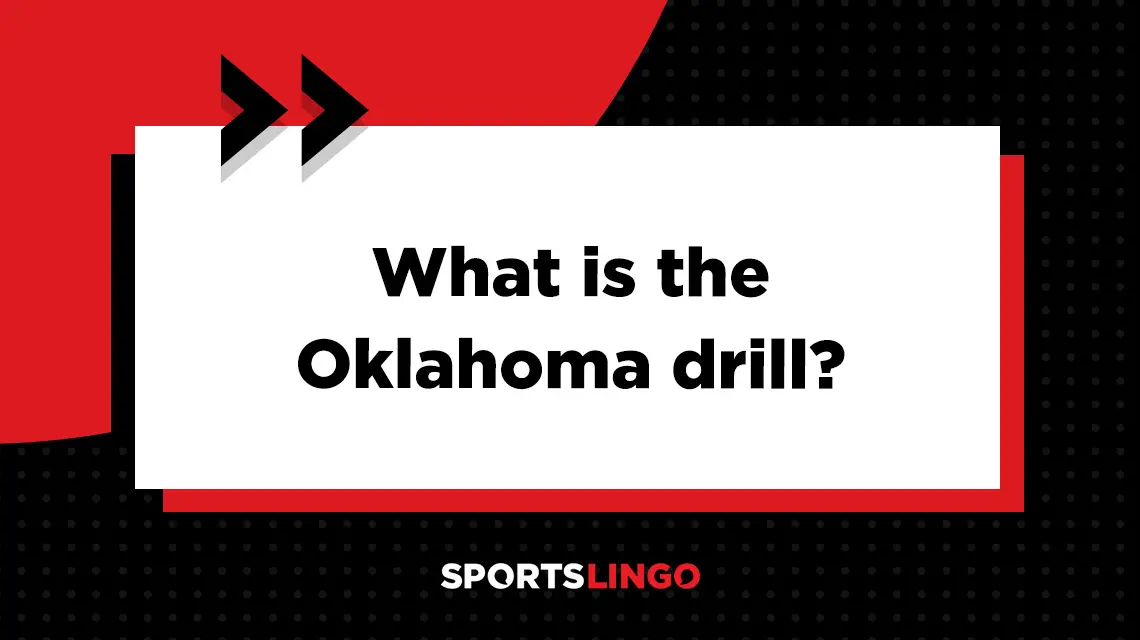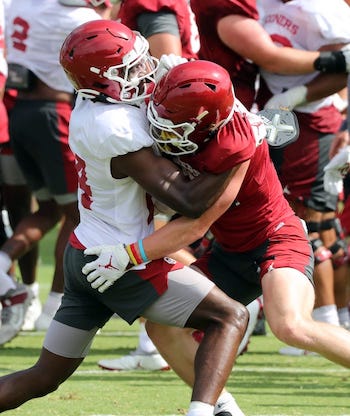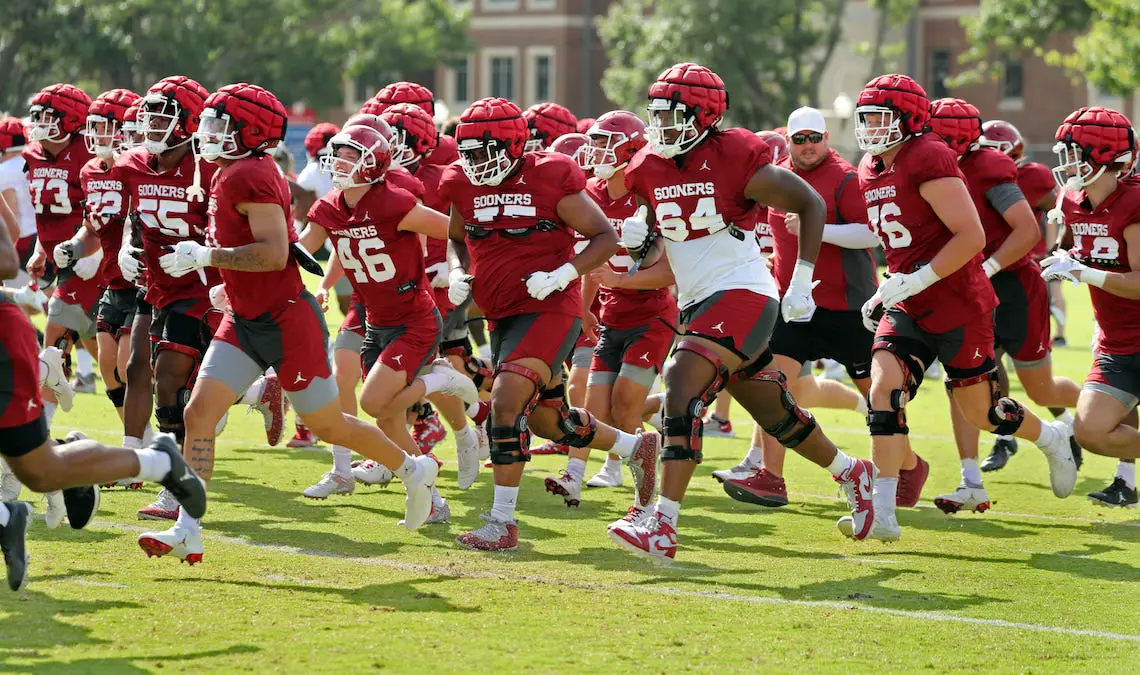
o*kla*hom*a drill
What is the definition of Oklahoma drill in football?
1. The Oklahoma drill is a full contact drill in football in which an offensive blocker and a defender face off against each other. The players are positioned three yards apart in a corridor that is at least one-yard wide. The boundaries of the corridor are usually marked off by pads or blocking bags, with the total area of the corridor measured at about three feet by nine feet.
When the whistle sounds, the drill begins and both players then rush towards each other until either someone ends up on the ground or is pushed out of bounds.
Another variation of the drill involves a total of three players, when a ball carrier is added to the drill. The drill is conducted the same as previously mentioned, but can now end if the ball carrier is tackled.
The purpose of the drill is to test players in full contact, confined situations.
Why is it called the Oklahoma drill?
The drill was created by former Oklahoma Sooners head coach Bud Wilkinson, which is why the name includes “Oklahoma.”
When was the Oklahoma drill created?
Wilkinson instituted the drill with the Sooners after he took over as head coach in 1947. At the time, it was just known as the one-on-one drill. But as the Sooners became a college football powerhouse, other coaches picked up the drill and brought it back to their own teams.
What does the Oklahoma drill consist of?

Traditionally, the Oklahoma drill pits two players against one another: a blocker and a defender. The players line up a few yards apart in a narrow lane, which is typically created with blocking bags or pads. The coach blows a whistle to start the drill, and the players rush at one another in an attempt to tackle their opponent or push them out of bounds.
The Oklahoma drill can also include different variations in terms of the number of players involved. For example, a coach may choose to have a ball carrier or running back and an offensive blocker (such as a tight end) face off against a player from the defensive line, such as a linebacker. The blocker from the offensive line tries to get the ball carrier or running back past the defender, while the defensive player focuses on tackling the offensive lineman and ball carrier. This helps to create similar conditions for when a ball carrier rushes to gain yards or score a touchdown.
Other variations of the drill may include matchups of one-on-two, two-on-two, two-on-three, etc. The lane in which the players face off is typically widened when more players are involved.
How do you win the Oklahoma drill?
The winner of each one-on-one test in the Oklahoma Drill is the player who either tackles their opponent to the ground or pushes them out of bounds.
When a ball carrier is added to the drill, the winner is the blocker if the ball carrier is able to make it past safely. If the ball carrier is tackled, the defender wins.
What is the purpose of the Oklahoma drill?
The Oklahoma drill is designed to see how football players perform in full contact situations. It helps the defensive and offensive players to practice and develop their skills in a controlled setting. In addition, the intensity of the matchups can help players to prepare mentally and physically for the demands of a real game. The drill may also aid in a kind of primal team bonding due to the fact that all the players are submitted to such a grueling task.
Coaches use the Oklahoma drill to assess the skills of individual players. Unlike a scrimmage, the Oklahoma drill gives coaches a chance to zero in on a limited number of players to closely examine their tackling or blocking abilities. Coaches have been known to use the Oklahoma drill to begin a football team’s first day of full contact practice for the season. This provides a method of evaluating players who have only participated in non-contact drills up to that point.
Is the Oklahoma drill dangerous?
The Oklahoma drill is often viewed as an old-school approach to American football. This drill has been used to prove a player’s toughness, grit, and skill in full speed, full contact situations, which naturally creates a risk of injury. However, there are growing concerns about the long-lasting physical damage that may be caused by these types of football drills, especially those involving unnecessary helmet contact.
In recent years, more teams have stopped using the Oklahoma drill as part of their training. As concerns about head injuries in football have been brought to light, some coaches are questioning whether the benefits outweigh the risks.
Is the Oklahoma drill allowed?
The NFL banned the Oklahoma drill from training camp practices in May 2019. Similarly, the National Collegiate Athletic Association (NCAA) prohibited the use of straight-line contact drills, including the Oklahoma drill, from college football practices in May 2021. Some states have also banned the use of these types of contact drills at the high school level.
These rules were put into effect in order to help protect players from injury, especially those resulting in concussions. The NCAA also noted in their decision that these drills do not simulate scenarios which are realistic to ones that players encounter in actual games.

Steve Sisney/USA TODAY Sports
Why was the Oklahoma drill banned?
Bans on the Oklahoma drill are done in an effort to make practices safer and protect players from injury. Many consider the drill to be an example of unnecessary helmet contact, and by banning it, the goal is to reduce concussions and other head injuries.
Although the Oklahoma drill is still used by some college, high school and youth football coaches, it’s less prevalent than it once was.
What football drills are used instead of the Oklahoma drill?
Many teams have modified the Oklahoma drill to maintain some of its benefits while minimizing head-on contact. During his time as head coach for the Detroit Lions, Matt Patricia introduced a version of the Oklahoma drill in which players begin on their backs at get up at the sound of the whistle. Then, the tackler attempts to tag the ball carrier rather than tackle them. Players run the drill at full speed and worked on how to position themselves for effective tackles to encourage muscle memory of these techniques. However, less contact between players helps to reduce the risk of injury. Patricia also hoped that this type of drill would prevent the team from becoming worn out before their season began.
Kirby Smart, head coach of the University of Georgia Bulldogs, created another alternative version that he calls the Millennial Oklahoma. In this version, players still make contact, but they don’t run straight at each other in a narrow lane. The players are aligned in a spread formation rather than being confined in a small space and trying to smash through to the other side. Although Smart developed this version of the drill to make it more realistic to the current style of play in college football, it likely produces fewer injuries than the traditional Oklahoma drill.
Examples of how Oklahoma drill is used in commentary
1. For the first time during training camp, players for the New York Jets are going to put on the pads and finally hit each other with the Oklahoma drill.
SportsLingo goes the extra-inch with the meaning of Oklahoma drill
The Oklahoma drill is used to help evaluate players in a contact drill. In many cases, players may look promising during non-contact drills, but may play differently when contact is initiated. In some cases they players may play more poorly, while in other cases, the players may play better with contact.
Sport the term is used
1. Football
Also known as:
1. Pit drill